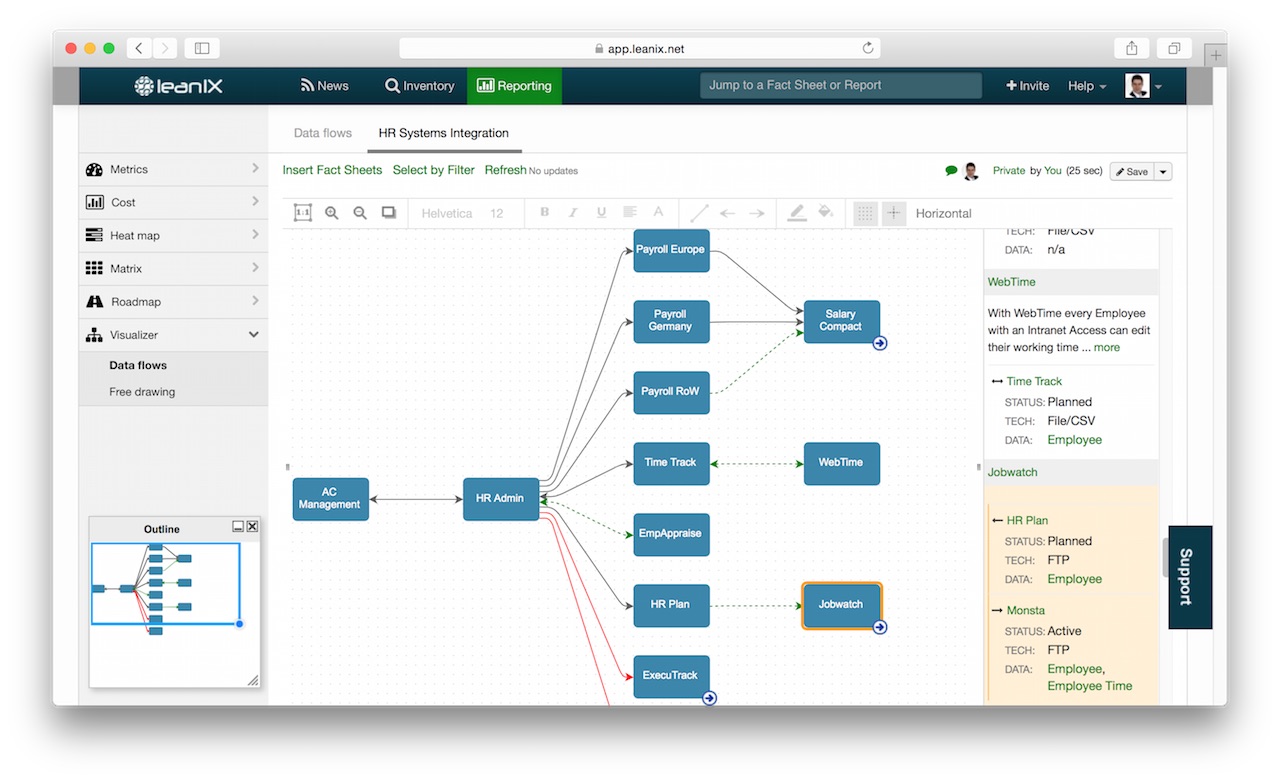

Today we are talking with one of our users, that we got introduced to by their investor Capnamic. We like introductions by VCs that are not invested in Giant Swarm (yet), so we were happy to have a deeper discussion with leanIX about their needs.
One of the points that brought us together is that the leanIX team had just rewritten parts of their stack for using Docker containers and were looking for DevOps help. Prime candidate we thought, because we think Giant Swarm can alleviate the pain of needing a dedicated DevOps person to some extent at the beginning and more so at later stages.
André, one of the founders, came by our office and said he started playing with Giant Swarm the night before and was more or less done migrating. Due to a small bug, his containers first didn’t come up, but after that was quickly fixed, everything worked and he had a running Dev environment. His biggest problem, if we can call it a problem, was that he was already using the private Docker Registry and needed to push containers into our registry first, which took some time.
O: But let’s start at the beginning. André, so what does leanIX do?
A: In the light of challenges such as digital transformation, mergers, and Industry 4.0 traditional companies need to really ramp up on their IT capabilities. Otherwise those concepts just stay abstract buzzwords.
For many companies the first step to make better decisions in IT is, to actually understand and manage their IT landscape better, namely getting started with enterprise architecture management (EAM). In the past many attempts to rollout EAM in companies have failed. Especially small and medium sized companies have failed to implement a proper tool for EAM that is actually used by employees – also beyond a small group of experts.
This is where leanIX comes in, putting a lightweight, web-based information platform in place. Answers to IT architecture questions can be retrieved by using contextual search filters, just as easy as booking your hotel online or as simple as shopping at Amazon.

O: One would imagine this stuff exists already. How come you have such success, getting customers like Zalando, Axel Springer, and Trusted Shops?
A: While EAM tools are kind of a niche market, there is quite a number of players active, many with a legacy of around 10 years. All of those tools were made for experts and you need to work through 800 pages of manual to get started with them.
leanIX in contrast offers a ready to use SaaS platform that allows a headstart in EAM. We had in mind to create B2B software, which is as easy as Google, as useful as Excel and as fun as Facebook. This makes sure that a variety of stakeholders in the company actually use the tool.
O: You bootstrapped the company for 3 years? What made you change your mind and take on an investor?
A: That is right. When building the company, we focused on revenues from the early start on. We had the first version of our product ready after 6 Months. We had our first paying customer only 3 Months later. So, the decision to take on an investor was not out of necessity but a very conscious decision to further foster growth. We felt that from a product and market perspective it was just perfect timing.
The Capnamic & IRIS investment enables us on the one hand to gain more visibility in the market. We are this year’s Platinum Sponsor of the most important EAM conference, the Gartner EAM summit in London. On the other hand we were able to further increase our team size, especially in development and on the marketing & sales side.
O: Tell us about your infrastructure. How is everything set up?
A: For our first MVP we started out with a mix of PHP, MySQL, SOLR Apache, Bootstrap, jQuery and yii. We found that at the time this was the best setup considering the knowledge in the team. And leanIX still builds on this infrastructure today.
But over time we got additional requirements, such as better enterprise integration and Single Sign On (SSO). Therefore, we have started to move to a microservices architecture based on Java (Dropwizard), which allows us to operate our existing services while at the same time build flexible new services.
In order to operate such a microservices architecture we found Docker an ideal choice. Therefore, we now have a highly automated toolchain with GitHub, Docker, Jenkins, and Ansible. With our setup today we can deploy our entire stack to any freshly installed Linux server within a couple of minutes.
O: Where do you see Giant Swarm helping first?
A: During the last couple of months, we have put quite some effort into DevOps topics like Docker, Ansible, etc. This helped us a lot to shape our requirements and the critical factors of an effective and efficient deployment architecture. But as we are a SaaS company, we want to focus all our energy on building easy to use software.
We see that Giant Swarm can support in scaling our offers, taking away a large bunch of DevOps tasks – freeing time for building our products. Additionally, Giant Swarm has recruited great talent in this field. As we strongly believe in ecosystems, we are happy to see an emerging market of service providers in der Docker space – Giant Swarm being one of them - made in Germany, which is very attractive for us and our customers.
Nevertheless, there are a couple of topics we still need to address together prior to going live, such as availability of other registries or speeding up of container starts. But these are not rocket science, so I’m convinced they will be included in future versions of the service.
O: Yes, we need to make different registries available, but the decision for our own was taken when most people we talked to didn’t have private repository access, yet. Something that is likely changing. As for slow container starts, that has already greatly improved and will further speed up with our move to a new fully 10Gbit and SSD bare metal hosting environment this month. Can you envision a time when production instances could run on Giant Swarm?
A: We have now decided on a joint roadmap with clearly defined steps, how leanIX can benefit from Giant Swarm. One of the first steps will be to deploy our demo instances in the Swarm. At LeanIX, customers can try out the solution for 30 days – this is already an ideal scenario for which we can spin up new containers as needed and remove them, once the trial period is over (and the customer has hopefully decided to use leanIX as the tool of choice).
From there, we will move into production for new customers and time will tell if we move older installations over and whether we can handle on premise solutions with the Swarm.
O: André, thank you very much for the interview. We are looking forward to continue on this path together.
About leanIX:
leanIX offers an innovative software-as-a-service solution for Enterprise Architecture Management (EAM), based either in a public cloud or the client’s data center. The web-based platform has compelling advantages over traditional approaches, including an intuitive interface, flexible reporting and open APIs. This makes it possible to rapidly roll out leanIX in an enterprise with minimal training required so as to start reaping added value within a short period of time. Both SMEs and large corporations from an array of industries are utilizing the solution – companies like Axel Springer, Helvetia, RWE, Vaillant, and Trusted Shops. Businesses of all sizes are being acquired as customers, firms which used to be reluctant regarding EAM or had had frustrating experiences with cumbersome tools. leanIX GmbH was formed in 2012 by Jörg G. Beyer and André Christ. With headquarters in Bonn, the company’s large partner network extends throughout Europe and to Australia and the US.
These Stories on Inside
Remote by design, connected by culture – that's the Giant Swarm way.
Embark on a nostalgic journey through the Giant Swarm blog archives, uncovering hidden wisdom in this exploration of past, present, and future blog posts.
Discover the perfect blend of work and play with Giant Swarm's Giant Mansions concept. Remote teamwork, redefined as an adventure!
We empower platform teams to provide internal developer platforms that fuel innovation and fast-paced growth.
GET IN TOUCH
General: hello@giantswarm.io
CERTIFIED SERVICE PROVIDER
No Comments Yet
Let us know what you think